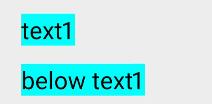HarmonyOS之常用布局DependentLayout的使用
Posted Forever_wj
tags:
篇首语:本文由小常识网(cha138.com)小编为大家整理,主要介绍了HarmonyOS之常用布局DependentLayout的使用相关的知识,希望对你有一定的参考价值。
一、DependentLayout 简介
- DependentLayout 是 Java UI 系统里的一种常见布局。与DirectionalLayout 相比,拥有更多的排布方式,每个组件可以指定相对于其他同级元素的位置,或者指定相对于父组件的位置。
- DirectionalLayout 布局方式,请参考我的博客:HarmonyOS之常用布局DirectionalLayout的使用。
- DependentLayout 布局示意如下:

二、支持的 XML 属性
- DependentLayout 的共有 XML 属性继承自 Component,详情请参考我的博客:HarmonyOS之组件通用的XML属性总览。
- DependentLayout 的自有 XML 属性见下表:
| 属性名称 | 中文描述 | 取值 | 取值说明 | 使用案例 |
|---|---|---|---|---|
| alignment | 对齐方式 | left | 表示左对齐 | 可以设置取值项如表中所列,也可以使用“|”进行多项组合。 ohos:alignment="top|left" ohos:alignment="left" |
| top | 表示顶部对齐 | |||
| left | 表示左对齐 | |||
| bottom | 表示底部对齐 | |||
| horizontal_center | 表示水平居中对齐 | |||
| vertical_center | 表示垂直居中对齐 | |||
| center | 表示居中对齐 |
- DependentLayout 所包含组件可支持的 XML 属性见下表:
| 属性名称 | 中文描述 | 取值 | 取值说明 | 使用案例 |
|---|---|---|---|---|
| left_of | 将右边缘与另一个子组件的左边缘对齐 | 引用 | 仅可引用DependentLayout中包含的其他组件的id | ohos:left_of="$id:component_id" |
| right_of | 将左边缘与另一个子组件的右边缘对齐 | ohos:right_of="$id:component_id" | ||
| start_of | 将结束边与另一个子组件的起始边对齐 | ohos:start_of="$id:component_id" | ||
| end_of | 将起始边与另一个子组件的结束边对齐 | ohos:end_of="$id:component_id" | ||
| above | 将下边缘与另一个子组件的上边缘对齐 | ohos:above="$id:component_id" | ||
| below | 将上边缘与另一个子组件的下边缘对齐 | ohos:below="$id:component_id" | ||
| align_baseline | 将子组件的基线与另一个子组件的基线对齐 | ohos:align_baseline="$id:component_id" | ||
| align_left | 将左边缘与另一个子组件的左边缘对齐 | ohos:align_left="$id:component_id" | ||
| align_top | 将上边缘与另一个子组件的上边缘对齐 | ohos:align_top="$id:component_id" | ||
| align_right | 将右边缘与另一个子组件的右边缘对齐 | ohos:align_right="$id:component_id" | ||
| align_bottom | 将底边与另一个子组件的底边对齐 | ohos:align_bottom="$id:component_id" | ||
| align_start | 将起始边与另一个子组件的起始边对齐 | ohos:align_start="$id:component_id" | ||
| align_end | 将结束边与另一个子组件的结束边对齐 | ohos:align_end="$id:component_id" | ||
| align_parent_left | 将左边缘与父组件的左边缘对齐 | boolean类型 | 可以直接设置true/false,也可以引用boolean资源 | ohos:align_parent_left="true" ohos:align_parent_left="$boolean:true" |
| align_parent_top | 将上边缘与父组件的上边缘对齐 | ohos:align_parent_top="true" ohos:align_parent_top="$boolean:true" | ||
| align_parent_right | 将右边缘与父组件的右边缘对齐 | ohos:align_parent_right="true" ohos:align_parent_right="$boolean:true" | ||
| align_parent_bottom | 将底边与父组件的底边对齐 | ohos:align_parent_bottom="true" ohos:align_parent_bottom="$boolean:true" | ||
| align_parent_start | 将起始边与父组件的起始边对齐 | ohos:align_parent_start="true" ohos:align_parent_start="$boolean:true" | ||
| align_parent_end | 将结束边与父组件的结束边对齐 | ohos:align_parent_end="true" ohos:align_parent_end="$boolean:true" | ||
| center_in_parent | 将子组件保持在父组件的中心 | ohos:center_in_parent="true" ohos:center_in_parent="$boolean:true" | ||
| horizontal_center | 将子组件保持在父组件水平方向的中心 | ohos:horizontal_center="true" ohos:horizontal_center="$boolean:true" | ||
| vertical_center | 将子组件保持在父组件垂直方向的中心 | ohos:vertical_center="true" ohos:vertical_center="$boolean:true" |
三、排列方式
- DependentLayout 的排列方式是相对于其他同级组件或者父组件的位置进行布局。
① 相对于同级组件
- end_of
-
- 如下图所示:

-
- 示例代码:
<?xml version="1.0" encoding="utf-8"?>
<DependentLayout
xmlns:ohos="http://schemas.huawei.com/res/ohos"
ohos:width="match_content"
ohos:height="match_content"
ohos:background_element="$graphic:color_light_gray_element">
<Text
ohos:id="$+id:text1"
ohos:width="match_content"
ohos:height="match_content"
ohos:left_margin="15vp"
ohos:top_margin="15vp"
ohos:bottom_margin="15vp"
ohos:text="text1"
ohos:text_size="20fp"
ohos:background_element="$graphic:color_cyan_element"/>
<Text
ohos:id="$+id:text2"
ohos:width="match_content"
ohos:height="match_content"
ohos:left_margin="15vp"
ohos:top_margin="15vp"
ohos:right_margin="15vp"
ohos:bottom_margin="15vp"
ohos:text="end_of text1"
ohos:text_size="20fp"
ohos:background_element="$graphic:color_cyan_element"
ohos:end_of="$id:text1"/>
</DependentLayout>
-
- color_light_gray_element.xml:
<?xml version="1.0" encoding="utf-8"?>
<shape xmlns:ohos="http://schemas.huawei.com/res/ohos"
ohos:shape="rectangle">
<solid
ohos:color="#EDEDED"/>
</shape>
-
- color_cyan_element.xml:
<?xml version="1.0" encoding="utf-8"?>
<shape xmlns:ohos="http://schemas.huawei.com/res/ohos"
ohos:shape="rectangle">
<solid
ohos:color="#00FFFD"/>
</shape>
- below
-
- 如下图所示:

-
- 示例代码:
<?xml version="1.0" encoding="utf-8"?>
<DependentLayout
xmlns:ohos="http://schemas.huawei.com/res/ohos"
ohos:width="match_content"
ohos:height="match_content"
ohos:background_element="$graphic:color_light_gray_element">
<Text
ohos:id="$+id:text1"
ohos:width="match_content"
ohos:height="match_content"
ohos:left_margin="15vp"
ohos:top_margin="15vp"
ohos:right_margin="40vp"
ohos:text="text1"
ohos:text_size="20fp"
ohos:background_element="$graphic:color_cyan_element"/>
<Text
ohos:id="$+id:text2"
ohos:width="match_content"
ohos:height="match_content"
ohos:left_margin="15vp"
ohos:top_margin="15vp"
ohos:right_margin="40vp"
ohos:bottom_margin="15vp"
ohos:text="below text1"
ohos:text_size="20fp"
ohos:background_element="$graphic:color_cyan_element"
ohos:below="$id:text1"/>
</DependentLayout>
-
- color_light_gray_element.xml:
<?xml version="1.0" encoding="utf-8"?>
<shape xmlns:ohos="http://schemas.huawei.com/res/ohos"
ohos:shape="rectangle">
<solid
ohos:color="#EDEDED"/>
</shape>
-
- color_cyan_element.xml:
<?xml version="1.0" encoding="utf-8"?>
<shape xmlns:ohos="http://schemas.huawei.com/res/ohos"
ohos:shape="rectangle">
<solid
ohos:color="#00FFFD"/>
</shape>
- 其他的 above、start_of、left_of、right_of 等参数可分别实现类似的布局。
② 相对于父组件
- 以上位置布局可以组合,形成处于左上角、左下角、右上角、右下角的布局,如下:

- 示例代码:
<?xml version="1.0" encoding="utf-8"?>
<DependentLayout
xmlns:ohos="http://schemas.huawei.com/res/ohos"
ohos:width="300vp"
ohos:height="100vp"
ohos:background_element="$graphic:color_background_gray_element">
<Text
ohos:id="$+id:text6"
ohos:width="match_content"
ohos:height="match_content"
ohos:text="align_parent_right"
ohos:text_size="12fp"
ohos:background_element="$graphic:color_cyan_element"
ohos:align_parent_right="true"
ohos:center_in_parent="true"/>
<Text
ohos:id="$+id:text7"
ohos:width="match_content"
ohos:height="match_content"
ohos:text="align_parent_bottom"
ohos:text_size="12fp"
ohos:background_element="$graphic:color_cyan_element"
ohos:align_parent_bottom="true"
ohos:center_in_parent="true"/>
<Text
ohos:id="$+id:text8"
ohos:width="match_content"
ohos:height="match_content"
ohos:text="center_in_parent"
ohos:text_size="12fp"
ohos:background_element="$graphic:color_cyan_element"
ohos:center_in_parent="true"/>
<Text
ohos:id="$+id:text9"
ohos:width="match_content"
ohos:height="match_content"
ohos:text="align_parent_left_top"
ohos:text_size="12fp"
ohos:background_element="$graphic:color_cyan_element"
ohos:align_parent_left="true"
ohos:align_parent_top="true"/>
</DependentLayout>
- color_background_gray_element.xml:
<?xml version="1.0" encoding="utf-8"?>
<shape xmlns:ohos="http://schemas.huawei.com/res/ohos"
ohos:shape="rectangle">
<solid
ohos:color="#ffbbbbbb"/>
</shape>
- color_cyan_element.xml:
<?xml version="1.0" encoding="utf-8"?>
<shape xmlns:ohos="http://schemas.huawei.com/res/ohos"
ohos:shape="rectangle">
<solid
ohos:color="#00FFFD"/>
</shape>
四、场景示例
- 使用 DependentLayout 可以轻松实现内容丰富的布局,如下图所示:

- 源码示例:
<?xml version="1.0" encoding="utf-8"?>
<DependentLayout
xmlns:ohos="http://schemas.huawei.com/res/ohos"
ohos:width="match_parent"
ohos:height="match_content"
ohos:background_element="$graphic:color_background_gray_element">
<Text
ohos:id="$+id:text1"
ohos:width="match_parent"
ohos:height="match_content"
ohos:text_size="25fp"
ohos:top_margin="15vp"
ohos:left_margin="15vp"
ohos:right_margin="15vp"
ohos:background_element="$graphic:color_gray_element"
ohos:text="Title"
ohos:text_weight="1000"
ohos:text_alignment="horizontal_center"
/>
<Text
ohos:id="$+id:text2"
ohos:width="match_content"
ohos:height="120vp"
ohos:text_size="10fp"
ohos:background_element="$graphic:color_gray_element"
ohos:text="Catalog"
ohos:top_margin="15vp"
ohos:left_margin="15vp"
ohos:right_margin="15vp"
ohos:bottom_margin="15vp"
ohos:align_parent_left="true"
ohos:text_alignment="center"
ohos:multiple_lines="true"
ohos:below="$id:text1"
ohos:text_font="serif"/>
<Text
ohos:id="$+id:text3"
ohos:width="match_parent"
ohos:height="120vp"
ohos:text_size="25fp"
ohos:background_element="$graphic:color_gray_element"
ohos:text="Content"
ohos:top_margin="15vp"
ohos:right_margin="15vp"
ohos:bottom_margin="15vp"
ohos:text_alignment="center"
ohos:below="$id:text1"
ohos:end_of="$id:text2"
ohos:text_font="serif"/>
<Button
ohos:id="$+id:button1"
ohos:width="70vp"
ohos:height="match_content"
ohos:text_size="15fp"
ohos:background_element="$graphic:color_gray_element"
ohos:text="Previous"
ohos:right_margin="15vp"
ohos:bottom_margin="15vp"
ohos:below="$id:text3"
ohos:left_of="$id:button2"
ohos:italic="false"
ohos:text_weight="5"
ohos:text_font="serif"/>
<Button
ohos:id="$+id:button2"
ohos:width="70vp"
ohos:height="match_content"
ohos:text_size="15fp"
ohos:background_element="$graphic:color_gray_element"
ohos:text="Next"
ohos:right_margin="15vp"
ohos:bottom_margin="15vp"
ohos:align_parent_end="true"
ohos:below="$id:text3"
ohos:italic="false"
ohos:text_weight="5"
ohos:text_font="serif"/>
</DependentLayout>
- color_background_gray_element.xml:
<?xml version="1.0" encoding="utf-8"?>
<shape xmlns:ohos="http://schemas.huawei.com/res/ohos"
ohos:shape="rectangle">
<solid
ohos:color="#ffbbbbbb"/>
</shape>
- color_gray_element.xml:
<?xml version="1.0" encoding="utf-8"?>
<shape xmlns:ohos="http://schemas.huawei.com/res/ohos"
ohos:shape="rectangle">以上是关于HarmonyOS之常用布局DependentLayout的使用的主要内容,如果未能解决你的问题,请参考以下文章